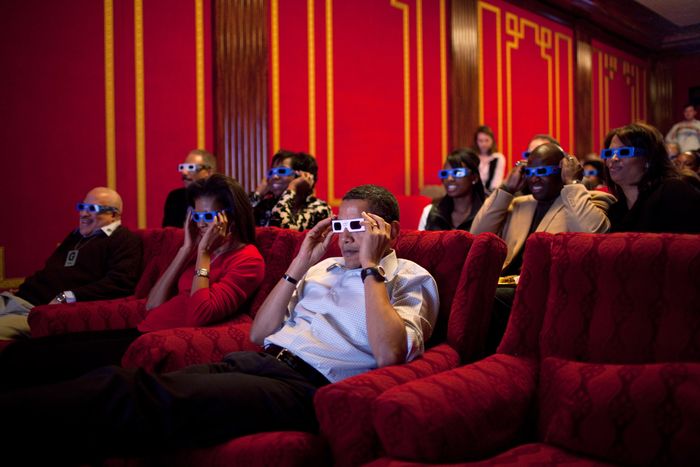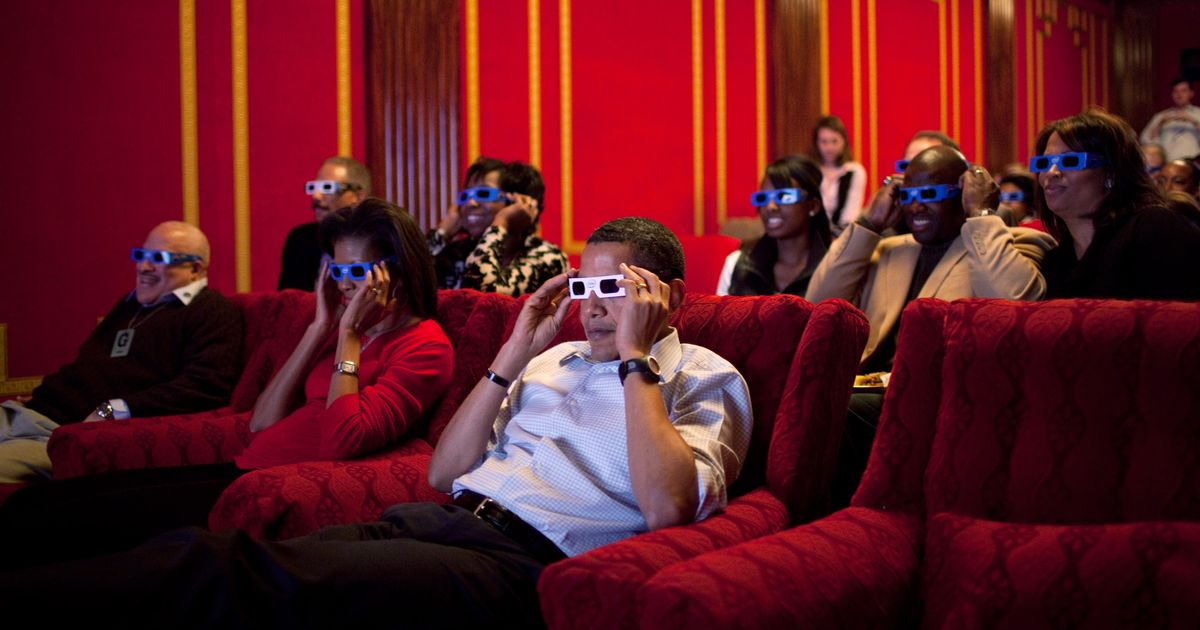
Photo: Pete Souza/White House via Getty Images
As President Donald Trump continues to remake the White House in his own pyrite image, one of the casualties of his East Wing demolition is the 83-year-old Family Theater, the small cinema for the commander-in-chief and his family, friends, and colleagues. Before the streaming age, presidents had the closest thing to an on-demand theater as one could find in the world — they could request a showing of any movie, including ones that hadn’t been released yet, if they wanted to unwind with their wife, a mistress, Cabinet members, and visiting heads of state.
“It’s the president inviting guests into his family room, where people could lay back,” says Burt Kearns, co-director of the documentary All the Presidents’ Movies. “Through the study of the screening room, you get a sense not only of the president’s taste but how it jibes with that of the general public.” Alongside fellow director Brett Hudson, Kearns helped shed light on the history of cinema in the White House, aided by the logs of theater projectionist Paul Fischer. The meticulous Fischer kept notes on the 5,000-plus movies he showed from the Eisenhower to Reagan administrations, detailing who was in the room for each, adding a pop-culture context to historic events. With the East Wing reduced to rubble, Vulture caught up with Kearns to discuss the theater’s role in presidential history and why it was so much more than a 42-seat screening room.
What was your reaction to the news that the theater was torn down?
Let’s hope they’re telling the truth about it being rebuilt and modernized. I think it’s, sadly, a sign of the times that the White House theater was destroyed as sort of an afterthought. It’s a valuable piece of American history that’s gone. The screening room itself lasted 83 years. It was built from a cloakroom during the FDR administration and it lasted through Trump. They put in Dolby Sound during the Reagan administration and Laura Bush introduced plush chairs, red carpet, and, as Trump would appreciate, some gold trim around the theater.
And through that screening room and what went on there, we got to learn a lot about the presidents. There was a lot of value to it. Bill Clinton called it the best perk of the White House, being able to make a phone call and get any movie at any time of the day to watch. You always see that in movies — you’re the president, you can make a phone call down to the kitchen in the middle of the night and get a peanut butter and jelly sandwich. With streaming now you can do it instantly but it was different — there’s a movie you want to see, it’s not out yet, you make that call and the next day, or sometimes that day, it’s shipped over and you’ve got it.
How do you think the decision relates to the administration’s apparent negative view of the arts, with cutting grant funding and creating AI slop videos, among other things?
I don’t really want to comment on that. President Trump considers himself to be a patron of the arts and he’s got his own tastes, as we know. I’m sure there will be screenings of the film Catsif there haven’t been already, because I know he really digs Cats. It’s sad to see a room like that go — it did have a real cultural significance, one that was much more personal than something bigger like the Kennedy Center.
This was the president at home, where he was able to keep up with popular culture with his family. Memories were made there and history was made there. It wasn’t like the Situation Room — it was a room where you could sit back, let your hair down, and enjoy a picture. Hopefully, that tradition will continue.
What are some of the more notable things that happened there?
Through Paul Fischer’s logs, we were able to connect movie screenings with historical events and also find out the personal tastes of the Presidents. You find out that the night before Nixon invaded Cambodia illegally during the Vietnam War, he was sitting in the screening room with Henry Kissinger watching Patton. You read that and it’s like, Wow, what a surprise. Or by taking the list of all the films and seeing who watched what, you find out that the film that was most watched by the presidents was High Noon with Gary Cooper. You know, one man alone having to make the decision, everybody else turns against him, and he goes up against the bad guys — that’s how, I guess, the president would see himself.
They would invite their friends in and watch and talk. You find out that JFK and Jackie Kennedy watched 22 films together in the screening room. The very first film they watched together was The Misfitswhich was Marilyn Monroe’s last picture. So, you know, what was he thinking? He was romantically connected to Marilyn Monroe, and that’s it the first movie they watched together?
And the only film in Paul Fischer’s voluminous logs that did not identify the guest in the screening room was with JFK. Fischer was very discreet, so he just said, “JFK plus one guest.” They were watching a British rock-and-roll film called Espresso Bongo — you’ve got to wonder what woman JFK was watching the film with while Jackie was away.
Were there any other notable screenings that coincided with world events, like Patton and Cambodia?
No, mostly there were advance screenings of pictures. The very first movie shown in the White House was during the Wilson administration (in 1915). It was Birth of a Nationthe movie that extolled the virtues of the Ku Klux Klan, which is pretty interesting. That was before the screening room came along.
Jimmy Carter had an advance screening of Apocalypse Now. Francis Ford Coppola brought it there and the Joint Chiefs of Staff, Secretary of Defense, Director of the Central Intelligence Agency were all there. It was while Coppola was still experimenting with the ending of the film. When it ended, Carter stood up and turned around and yelled to the projectionist, “What’s wrong? What’s going on here? What happened to the ending of the film?” and Fischer said, “I’m sorry, sir, that is the ending.” That didn’t go over very well.
Did any president have particularly odd tastes?
Well, notably, some presidents really liked films. Carter watched about 460 — every two and a half days, he and Rosalynn were watching another movie. You wonder why he had so much time to do that. He also showed the first X-rated film in the White House, which was Midnight Cowboy.
Obama told us that his favorite films at the time were The Godfather, Godfather IIand Lawrence of Arabiawhile Michelle Obama claimed that her favorite pictures were Shrek and Enchanted. So, figure that out. Eisenhower saw Angels in the Outfield four times. He also put a ban on Robert Mitchum films because Mitchum had been arrested for marijuana. Field of Dreams was a favorite of Bush Senior and Clinton. President Kennedy used the theater to audition actors for PT 109the movie about his World War II adventures. He also watched the James Bond films — the last film he watched before he headed off to Dallas was From Russia With Love.
LBJ wasn’t interested in films at all, but he loved to watch documentaries in which he was featured. He forced people to come in and watch them over and over again because he was the star. And so that’s where you have some hope for Trump — perhaps he’d have a lot of screenings of Home Alone 2.

اترك تعليقاً